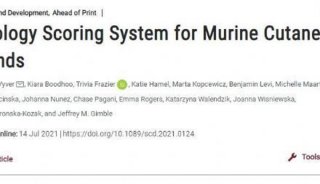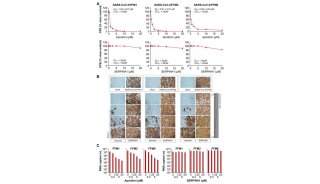Multicolour 3D-FISH in vertebrate cells-2
Small DNA-probes from cosmids or plasmids clones
These kind of probes, especially plasmids, have become out of fashion for 3D-FISH due to their delicate hybridization signals and the lack of a systematic compilation in databases. They are used only in special situations.
We strongly recommend preparing these probes by genomic DNA nick-translation, if not done by sequence-specific primer pairs. Amplification and/or labeling of these probes by universal DOP-PCR did not lead to satisfactory results in our hands (see note 9 and figure 4).
Nick-translation (see comment 2)
| 100µl NT-reaction mixture | Final concentration | |
| xµl | DNA (~2µg) | 2µg (less amount and up to 4µg is ok) |
| 10µl | NT-buffer 10x | 50mM TrisHCl, 5mM MgCl2, 50µg/ml BSA, pH=7.5 |
| 10µl | β-Mercaptoethanol (100mM) | 10mM |
| 10µl | dNTP-mix (10x) | 50µM dATP, dCTP, dGTP, each 10µM dTTP |
| 4µl | modified dUTP (e.g. Dig-dUTP) | 20µM 40µM in case of fluorochrome-labeled nucleotide |
| xµl ad 100µl | H20 bi-distilled | |
| 2µl | DNase I (2000 U/ml) | 0.016U |
| 2µl | Polymerase I (10 U/µl) | 0.2U |
* Dilute stock solution (2000 U/ml) 1:250 in ice-cold water and keep it on ice, use 2µl of this dilution per reaction
Incubate 90 minutes at 15°C -> freeze to -20°C and analyze the length of the fragments on a gel (ideal size 400-800 bp) -> further digestion if necessary using 1µl of diluted DNaseI for 15 minutes at 20°C -> finalize the reaction by adding 1µl of 0.5M EDTA (see note 10 and note 11).
Human pancentromeric, mouse major satellite and chromosome specific centromeric probes
To generate pancentromeric and mouse major satellite probes we highly recommend first to amplify the repetitive sequences by the following protocols and then label the primary amplified DNA by nick-translation. For the generation of chromosome specific pericentromeric probes we strongly recommend labeling by nick-translation from centromere specific sequences of genomic DNA. See figure 5.
Specific amplification of a pancentromeric probe (human)
| 100µl PCR-reaction mixture | Final concentration | |
| 10µl | GeneAmp PCR Buffer 10x (Applied Biosystems, N808-0130) | 1x (50mM KCl, 10mM Tris, pH8.3) |
| 8µl | MgCl2 (25mM) | 2mM |
| 2µl | a27 Primer* (100µM) | 2µM |
| 2µl | a30 Primer** (100µM) | 2µM |
| 2µl | Genomic DNA (100ng/µl) | 2ng/µl |
| 5µl | ACGT-Mix (each 2mM) | 100µM |
| 70µl | H2O Bi-distilled. | |
| 0.8µl | Taq-Polymerase (5U/µl) | |
*Primer sequence a27 (5'-CAT CAC AAA GAA GTTTCT GAG GCT TC)
**Primer sequence a30 (5'-TGC ATT CAACTC ACA GAG TTG AAC CTT CC)
Reference: Mitchell et al., (1985)
Features of the pancentromeric-amplification cycles
| x35 | Initial denaturation | 94°C 3'00'' |
| Denaturation | 94°C 0'45'' | |
| Annealing | 62°C 1'20'' | |
| Extension | 72°C 1'20'' | |
| Final extension | 72°C 5'00'' |
Specific amplification of mouse major satellite DNA
| 100µl PCR-reaction mixture | Final concentration | |
| 10µl | GeneAmp PCR Buffer 10x (Applied Biosystems, N808-0130) | 1x (50mM KCl, 10mM Tris, pH8.3) |
| 8µl | MgCl2 (25mM) | 2mM |
| 4µl | Forward primer* (25µM) | 1µM |
| 4µl | Reverse primer** (25µM) | 1µM |
| 10µl | Genomic DNA (10ng/µl) | 1ng/µl |
| 5µl | ACGT-mix (each 2mM) | 100µM |
| 58µl | H2O Bi-distilled. | |
| 0.8µl | Taq-Polymerase (5U/µl) | |
*Sequence of forward primer of mouse major satellite DNA: 5'-GCG AGA AAA CTG AAA ATC AC
**Sequence of reverse primer of mouse major satellite DNA: 5'-TCA AGT CGT CAA GTG GAT G
Reference: Horz and Altenburger (1981)
Features of the pancentromeric-amplification cycles
| x35 | Initial denaturation | 94°C 3'00'' |
| Denaturation | 94°C 1'00'' | |
| Annealing | 56°C 1'00'' | |
| Extension | 72°C 2'00'' | |
| Final extension | 72°C 5'00'' |
We highly recommend to label this primary amplified DNA by nick-translation.
Cell fixation and pre-treatment steps for an efficient permeabilization
Fixed cells require further pretreatment to obtain an efficient accessibility of the DNA probe to the nuclear target DNA. The individual steps listed below should be adjusted to the cell-type and requirements of hybridization probes in order to get an optimal balance between the preservation of the nuclear morphology and hybridization efficiency.
Treatment with the detergent Triton X100 and repeated freezing in liquid nitrogen after incubation in Glycerol helps to make nuclear DNA accessible for FISH probes without strongly affecting the 3D chromatin architecture. These two steps are generally sufficient for hybridization of highly repetitive sequences, e.g. centromeric regions.
Additional deproteinization steps are necessary when single copy DNA sequences are targeted. There are two methods of deproteinization: (i) incubation in HCl and (ii) digestion with pepsin. These pretreatments may be combined or used separately. In many cases, a short incubation in 0.1N HCl makes nuclear DNA sufficiently accessible for probes. Nevertheless, depending on the cell type processed, additional pepsin treatment may improve hybridization signals e.g. cosmid probes. Pepsin incubation should be monitored under the microscope as the duration of pepsin treatment critically affects the preservation of the nuclear morphology. It tends to alter the 3D morphology of the nuclei more than incubation in 0.1N HCl.
If a strong background develops after DNA/DNA hybridization due to a high content of RNA in nuclei or cytoplasm, cells should be treated with RNAse. RNase treatment is also necessary as a control for DNA/RNA hybridization. We present standard protocols for the fixation and pretreatment of adherently growing cells and cells growing in and pepsin treatment (see note 12).
Fixation of adherently growing cells for 3D-FISH
Rinse cells in 2-3 changes of PBS at 37°C.
Fix in 4% paraformaldehyde in PBS (freshly made, pH 7.0) 10 minutes at room temperature (RT). During the last minute add few drops of 0.5% TritonX-100/PBS.
Wash in PBS with 0.01% TritonX-100 -> 3x3 minutes, RT.
0.5% TritonX-100/PBS -> 5-15 minutes, RT.
20% Glycerol in PBS -> at least, 60 minutes, RT (better over night (ON)).
Freeze in liquid nitrogen (15-30 seconds), thaw gradually at RT, soak in 20% Glycerol/PBS -> repeat 4 to 6 times.
Wash in PBS, 3x10 minutes.
Incubate 5 minutes in 0.1M HCl.
Rinse in 2xSSC
Incubate in 50% formamide (pH = 7.0)/2xSSC (at least 30 minutes at RT, or ON at RT; or few days at +4°C).
Slides can be kept in 50% formamide for several months. (See note 13)
Fixation of cells growing in suspension for 3D-FISH (e.g. lymphoblastoid cells)
Incubate dried coverslips (stored in 80% EtOH) 1 hour with ~150µl Poly-Lysine Hydrobromide (1mg/ml). We recommend to put the drop of Poly-Lysine on a piece of Parafilm or in a Petri dish and place the coverslip on the drop;
Flush in H2O bi-dist. and air-dry the cover slips;
We recommend to use roughly 1ml of a actively growing cell culture per 22x22mm cover slips -> Spin suspension of cells 10 minutes at 1000rpm -> Discard supernatant and resuspend the pellet in RPMI/50%FCS. In order to obtain an appropriate number of cells on the slide we recommend to resuspend the cell in about ¼ of the initial volume (see comment 3);
Place ~200µl of cell-suspension on a coverslip and incubate for 1 hour at 37°C in an incubator -> Check attachment of cells under the microscope, briefly drain off the medium.
Incubate 40-60 seconds in 0.3x PBS (this step prevents the shrinkage of these spherically shaped cells that are otherwise prone to collapse during the following fixation. However, keep this step to the time indicated; otherwise the nuclei will increase in size);
Fix in 4% Paraformaldehyde/0.3x PBS 10 minutes -> after 8 minutes add some drops of 0.5% Triton-X/PBS solution;
Wash 3x5 minutes in 0.05% Triton X/PBS;
Incubate in 0.5% TritonX/PBS for 20 minutes;
Transfer coverslips to 20% Glycerol/PBS and incubate at least 30 minutes at room temperature (better: incubate overnight at 4°C);
Freeze in liquid nitrogen (~30 seconds) and thaw on a piece of tissue paper. As soon as the frozen layer disappears, put the coverslip back to 20% Glycerol/PBS -> repeat 4x;
Wash in 0.05% TritonX/PBS 3x5 minutes;
Incubate 5 minutes in 0.1N HCl (varies in different cell types);
Wash 2x1 minute in 2xSSC;
Place coverslips at least 30 minutes in 50%Formamid + 2xSSC (up to a few months at 4°C);
Continue with optional pepsin digestion (see note 14).
-
科技前沿

-
科技前沿










